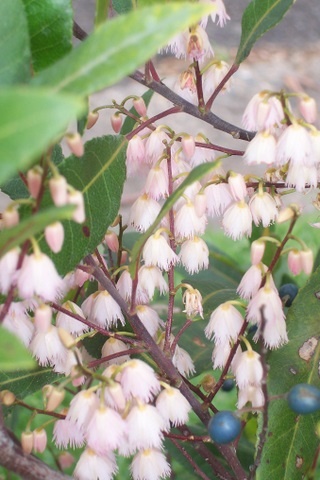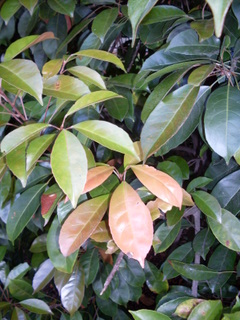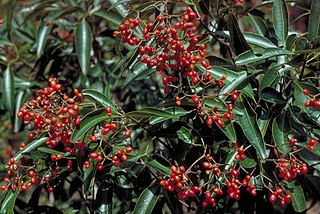
Elaeocarpus reticulatus, commonly known as blueberry ash, ash quandong, blue olive berry, fairy petticoats, fringe tree, koda, lily of the valley tree and scrub ash, is species of flowering plant in the family Elaeocarpaceae, and is endemic to eastern Australia. It is a shrub or small tree with oblong to elliptic leaves, racemes of white or pink flowers and blue, oval to spherical fruit.

Thomasia tenuivestita is a species of flowering plant in the family Malvaceae and is endemic to the south-west of Western Australia. It is a shrub with its new growth covered with greyish, star-shaped hairs, and has egg-shaped leaves, and racemes of mauve flowers.

Elaeocarpus grandis, commonly known as caloon, white quandong, blue quandong, silver quandong, blue fig or blueberry ash, is species of flowering plant in the family Elaeocarpaceae and is endemic to eastern Australia. It is a large tree with buttress roots at the base of the trunk, oblong to elliptic leaves with small teeth on the edges, racemes of greenish-white flowers and more or less spherical blue fruit.

Acradenia euodiiformis, commonly known as yellow satinheart or bonewood, is a species of tree that is endemic to eastern Australia. It has mostly trifoliate leaves, the leaflets narrow elliptic to lance-shaped, with prominent oil glands, and panicles of white flowers. It grows in and near rainforest.

Elaeocarpus kirtonii, commonly known as silver quandong, white quandong, brown hearted quandong, brownheart, mountain beech, Mowbullan whitewood, pigeonberry ash, white beech or whitewood, is species of flowering plant in the family Elaeocarpaceae and is endemic to eastern Australia. It is a large rainforest tree with buttress roots, regularly toothed, narrow elliptic to narrow oblong leaves, racemes of white flowers and pale blue, oval fruit.

Melicope micrococca, commonly known as hairy-leaved doughwood or white euodia, is a species of shrub or slender tree in the family Rutaceae and is endemic to eastern Australia. It has trifoliate leaves and white flowers borne in panicles in leaf axils.

Elaeocarpus eumundi, commonly known as Eumundi quandong, or smooth-leaved quandong, is a species of flowering plant in the family Elaeocarpaceae and is endemic to north-eastern Australia. It is a mid-sized tree with egg-shaped to lance-shaped leaves, racemes of cream-coloured flowers and blue fruit. It grows in rainforest from the Cape York Peninsula in Queensland to north-eastern New South Wales.

Vesselowskya rubifolia, commonly known as southern marara, red ash, mountain marara or Dorrigo southern marara, is a species of flowering plant in the family Cunoniaceae plant and has a restricted distribution in eastern New South Wales. It is a shrub or small tree with compound leaves with three or five leaflets with serrated edges, and small whitish flowers arranged along a raceme.

Podolobium aciculiferum, commonly known as needle shaggy-pea, is a flowering plant in the family Fabaceae and endemic to eastern Australia. It has stiff, pointed leaves and yellow pea-like flowers with red markings.

Cassinia subtropica, commonly known as bushy rosemary, is a species of flowering plant in the family Asteraceae and is endemic to north-eastern Australia. It is shrub with woolly-hairy stems, lance-shaped to egg-shaped leaves and panicles of flower heads.

Epacris calvertiana is a plant of the heath family, Ericaceae and is endemic to New South Wales. It is an erect to diffuse shrub with elliptic to egg-shaped leaves with a sharp-pointed tip and with white, pink or red flowers arranged along the ends of leafy branchlets.

Acronychia vestita, commonly known as white aspen, lemon aspen, hairy aspen or fuzzy lemon aspen, is a species of rainforest tree that is endemic to Queensland. It has simple, elliptic to egg-shaped leaves with the narrower end towards the base, flowers arranged in relatively large groups, mostly in leaf axils and fleshy, pear-shaped to more or less spherical fruit.

Bouchardatia neurococca, commonly known as union nut, is a species of small rainforest tree that is endemic to eastern Australia. It has pinnate leaves with three or five narrow elliptical leaflets, white flowers arranged in panicles, and oval follicles.

Dinosperma is a genus of plant containing the single species Dinosperma erythrococcum, commonly known as tingletongue, clubwood or nutmeg, and is endemic to north-eastern Australia. It is a tree usually with trifoliate leaves arranged in opposite pairs, the leaflets lance-shaped to oblong, and panicles of small white flowers, later bright orange to red, slightly fleshy follicles containing shiny, bluish black seeds.
Elaeocarpus arnhemicus, commonly known as elaeocarpus, blue plum, bony quandony or Arnhem Land quandong, is species of flowering plant in the family Elaeocarpaceae and is native to northern Australia, New Guinea, Timor and certain other islands in the Indonesian Archipelago. It is a tree with narrow elliptic to lance-shaped or egg-shaped leaves with serrated edges, racemes of white or cream-coloured flowers and metallic blue fruit.
Elaeocarpus foveolatus, commonly known as white quandong or northern quandong, is a species of flowering plant in the family Elaeocarpaceae and is endemic to Queensland. It is a medium-sized tree, sometimes with buttress roots at the base of the trunk, variably-shaped leaves with serrated edges, flowers with five petals often with a few short lobes or teeth on the tip, and elliptic to oval fruit.
Elaeocarpus grahamii is a species of flowering plant in the family Elaeocarpaceae and is endemic to north-east Queensland. It is a small to medium-sized tree, sometimes coppicing, with elliptic to egg-shaped leaves, flowers with five petals that have a frilled tip, and oval blue fruit.
Elaeocarpus johnsonii, commonly known as Kuranda quandong or Johnson's quandong, is species of flowering plant in the family Elaeocarpaceae and is endemic to north-east Queensland. It is a small to medium-sized tree, often with several main stems, elliptic to egg-shaped leaves with the narrower end towards the base, racemes of up to seven flowers, the petals with fringed lobes, and dark blue fruit.
Elaeocarpus ruminatus, commonly known as brown quandong, caloon or grey quandong, is a species of flowering plant in the family Elaeocarpaceae and is endemic to Queensland. It is a tree with buttress roots at the base of the trunk, mostly more or less elliptic leaves, cream-coloured flowers with five petals that sometimes have a divided tip, and more or less spherical fruit.
Elaeocarpus sericopetalus, commonly known as hard quandong, blueberry ash, hard duandong or northern quandong, is a species of flowering plant in the family Elaeocarpaceae and is endemic to Queensland. It is a tree, sometimes with buttress roots at the base of the trunk, relatively large lenticels, oblong to elliptic leaves, creamy-white flowers with five petals, and deep red to almost black fruit.

















